When it comes to creating a thriving shade garden, choosing the right perennials is key. From the classic beauty of hostas to the delicate allure of toad lilies, each plant brings its unique charm to the shaded landscape.
But what sets these perennials apart as the best options for shade gardens? Let’s explore further to uncover the secrets behind their resilience and beauty, and how they can transform your shaded sanctuary into an oasis of tranquility and color.
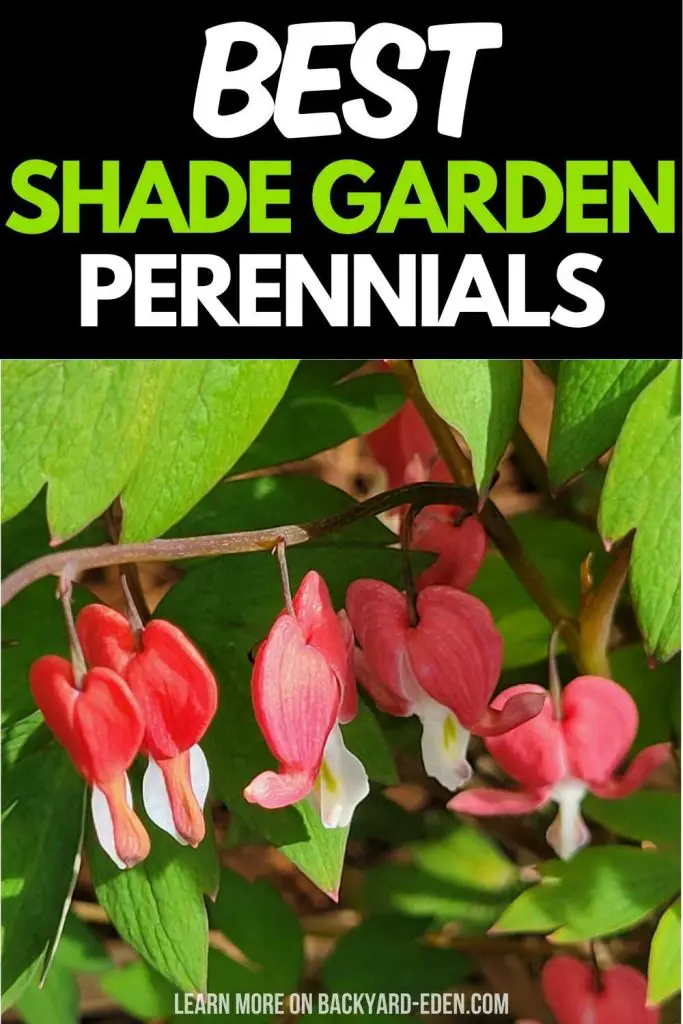
Key Takeaways
- Hostas offer diverse foliage colors and textures, suitable for containers.
- Astilbe blooms in various colors, thrives in partial to full shade.
- Ferns add elegance with lush greenery, maintain well-drained soil.
- Hellebores bloom in late winter, require low-maintenance care.
- Solomon’s Seal features arching stems, white flowers, ideal for low-light conditions.
Hostas

When selecting hostas for your shade garden, consider their unique foliage colors and textures to create a visually appealing landscape. Hosta varieties come in a wide range of colors, including lush greens, blues, yellows, and variegated patterns, offering you plenty of options to mix and match for a dynamic garden display.
To care for your hostas, make sure they’re planted in well-draining soil and receive adequate water, especially during hot summer months. Applying a layer of mulch around the base of the plants can help retain moisture and regulate soil temperature, promoting healthy growth.
Hostas are excellent choices for container gardening due to their adaptability to different growing conditions. When planting hostas in containers, make sure the pots have drainage holes to prevent waterlogging. Select smaller hosta varieties for containers, as they’re more suited to limited root space.
Regularly check the soil moisture levels and water accordingly, keeping in mind that container plants may dry out faster than those in the ground. With proper care, hostas can thrive in containers, adding beauty to your shaded outdoor spaces.
Ferns
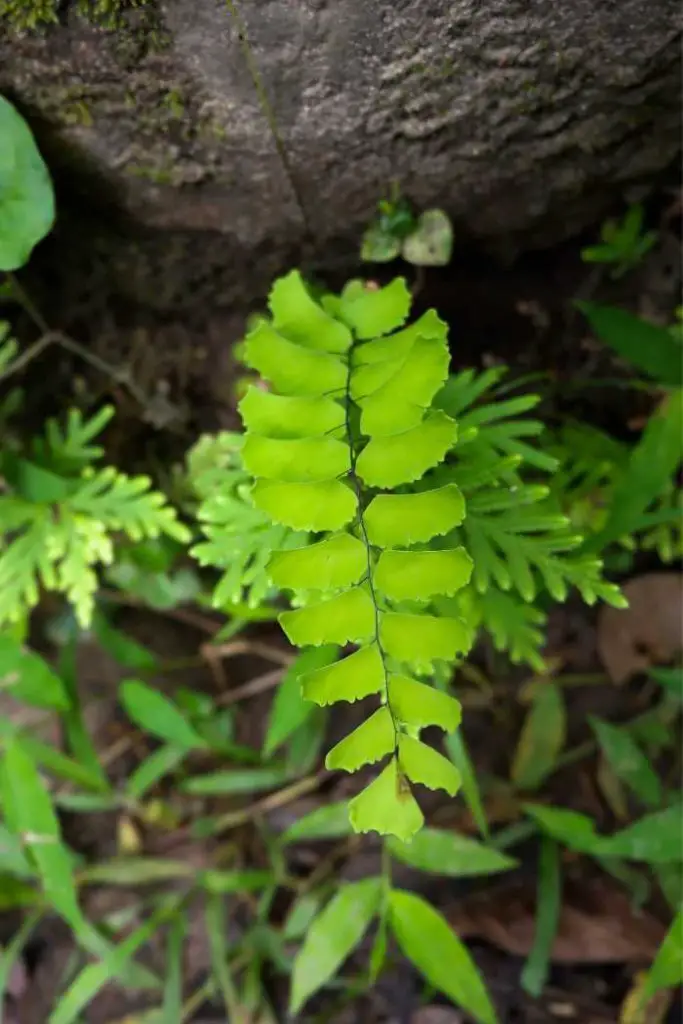
Consider the graceful fronds of ferns to add a touch of elegance and lush greenery to your shade garden landscape. Ferns are excellent choices for shaded areas due to their low maintenance and beautiful foliage.
When caring for ferns, make sure they have well-draining soil and consistent moisture. Mulching around the base of the plants can help retain moisture levels. It’s important to avoid over-fertilizing ferns, as they’re sensitive to high levels of nutrients.
When selecting fern varieties for your shade garden, think about the Japanese Painted Fern for its striking silvery fronds or the Lady Fern for its delicate, lacy appearance. The Ostrich Fern is another popular choice known for its large, feathery fronds that can reach impressive heights.
For a unique addition, try the Cinnamon Fern with its distinctive cinnamon-colored fertile fronds. Incorporating a variety of fern species can create a visually appealing and diverse shade garden.
Remember these fern care tips and explore different fern varieties to enhance the beauty of your outdoor space.
Astilbe

Enhance the vibrant colors and texture of your shade garden by introducing the elegant and versatile Astilbe plant. Astilbes are beloved for their feathery plumes of flowers that bloom in various shades like pink, red, purple, and white, adding a pop of color to your shaded areas.
When it comes to caring for astilbes, make sure they’re planted in moist, well-draining soil and provide them with consistent watering, especially during dry periods. These perennials thrive in partial to full shade, making them ideal for those shaded spots in your garden where other plants struggle to grow.
There is a wide range of astilbe varieties to choose from, each offering unique characteristics to suit your garden design. Some popular astilbe varieties include ‘Bridal Veil‘ with its white blooms, ‘Peach Blossom’ for soft pink flowers, and ‘Visions’ known for its striking red plumes.
By selecting different astilbe varieties, you can create a diverse and visually appealing shade garden that will bloom year after year with minimal maintenance.
Bleeding Heart

The Bleeding Heart plant, known for its unique heart-shaped flowers, brings a touch of elegance and charm to shaded garden spaces. When it comes to taking care of Bleeding Hearts, make sure they’re planted in well-drained soil with consistent moisture levels. Mulching around the plant can help retain moisture and suppress weeds. These perennials prefer partial to full shade, making them ideal for adding color to darker corners of your garden.
Propagation techniques for Bleeding Hearts can be done through division in the early spring or fall. Simply dig up the plant, divide the root clump into sections, and replant them in suitable locations. This method helps rejuvenate the plant and create new specimens for your garden or sharing with fellow gardening enthusiasts.
As for companion plants, Bleeding Hearts pair beautifully with other shade-loving perennials such as Hostas, Ferns, and Astilbes. The contrasting foliage textures and colors create a visually appealing garden bed. These combinations not only enhance the aesthetic appeal but also provide a healthy ecosystem for your plants to thrive.
Lungwort
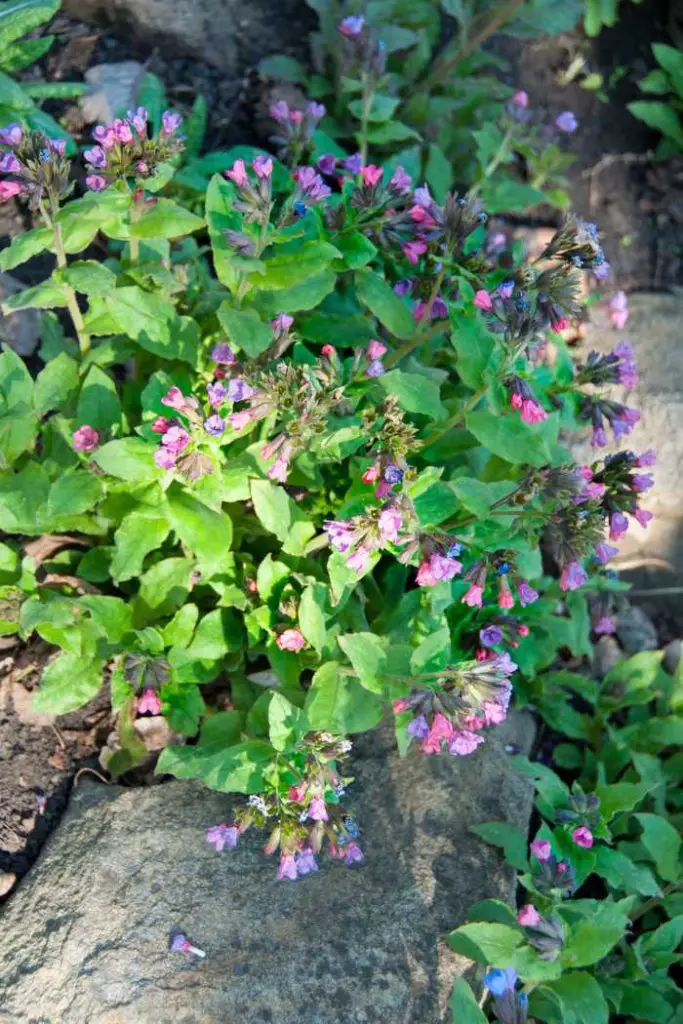
Lungwort, also known as Pulmonaria, is a versatile shade perennial that boasts unique silver-spotted leaves and clusters of tubular flowers in shades of pink, blue, or purple.
To grow Lungwort successfully, make sure it receives partial to full shade and moist, well-draining soil. These plants are low-maintenance and attract pollinators, making them a beautiful and beneficial addition to your shade garden.
Lungwort Characteristics
With its distinctive silver-spotted leaves and delicate pink, purple, or blue flowers, Lungwort is a versatile perennial that thrives in shady garden settings. Lungwort propagation is commonly done through division or by collecting and planting its seeds.
To propagate through division, separate the clumps of Lungwort in spring or fall, ensuring each new division has roots attached. Lungwort care tips include planting it in well-draining soil rich in organic matter, keeping the soil consistently moist but not waterlogged, and providing it with dappled shade or filtered sunlight.
Mulching around the base of the plant can help retain moisture and regulate soil temperature. Deadheading spent flowers can encourage more blooms and maintain a tidy appearance. Regularly inspecting for pests like slugs and snails is essential, as they can damage Lungwort leaves.
Lungwort Growing Tips
To guarantee successful growth of Lungwort in your shade garden, prioritize maintaining consistent moisture levels and conducting regular pest inspections. Lungworts, known for their charming spotted leaves and delicate flowers, thrive in shady areas with moist, well-draining soil. When it comes to lungwort care, make sure the soil remains consistently moist but not waterlogged. Mulching around the plants can help retain moisture and regulate soil temperature.
For the best shade garden design, consider planting lungworts alongside other shade-loving perennials like hostas, ferns, and astilbes. This creates a lush and visually appealing landscape while providing a suitable environment for the lungwort to flourish.
Regularly inspect your lungwort plants for common pests like slugs and snails, which are attracted to the moist conditions preferred by these perennials. If pest infestations occur, take appropriate measures to control them, such as handpicking pests or using organic pest control methods. By following these lungwort growing tips and incorporating them into your shade garden design, you can enjoy healthy and vibrant lungwort plants year after year.
Coral Bells
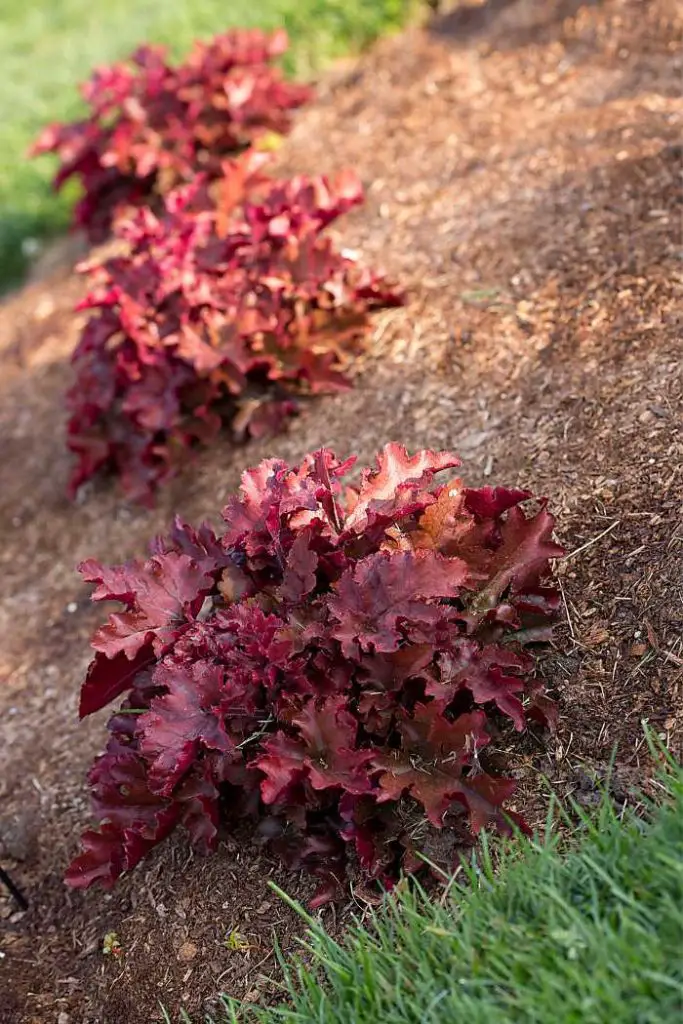
Coral Bells, also known as Heuchera, offer a vibrant array of foliage colors, making them a popular choice for shaded garden areas. These versatile plants thrive in low-light conditions, bringing life and color to those darker corners of your garden.
With their striking leaves and adaptability to shade, Coral Bells are an excellent addition to any shade garden, adding depth and interest to your outdoor space.
Colorful Foliage Options
Colorful foliage options add vibrancy and interest to shade gardens, with Coral Bells standing out as a popular choice. When considering variegated varietals and unique textures for your garden, Coral Bells offer a stunning array of leaf colors ranging from deep burgundy to lime green, adding depth and dimension to your outdoor space.
These plants aren’t only prized for their colorful leaves but also for their delicate bell-shaped flowers that bloom in spring and summer, attracting pollinators to your garden.
Coral Bells are excellent for creating seasonal color contrasts in your garden design. Their foliage can provide a striking backdrop for other shade-loving plants, enhancing the overall aesthetic of your outdoor sanctuary.
Whether you choose a single hue for a cohesive look or mix different Coral Bells varieties for a playful display, these plants are versatile and adaptable to various design preferences. With their alluring foliage and easy maintenance, Coral Bells are a must-have for any shade garden enthusiast looking to elevate their outdoor space.
Ideal for Shade
With their vibrant foliage and attractive bell-shaped flowers, Coral Bells are a top choice for shaded garden areas, adding depth and visual interest to your outdoor space. When it comes to shade garden design, Coral Bells thrive in partially shaded areas, making them versatile for different lighting conditions. Their varied leaf colors, ranging from deep burgundy to lime green, offer numerous plant combination possibilities, complementing other shade-loving plants like hostas or ferns.
Shade gardening challenges can include limited sunlight and competition for nutrients. However, Coral Bells are resilient and can adapt well to these conditions. To foster their growth, plant them in well-draining soil amended with organic matter to enhance nutrient retention. Regular watering is essential, especially during dry spells, to keep the soil consistently moist but not waterlogged.
Foamflower
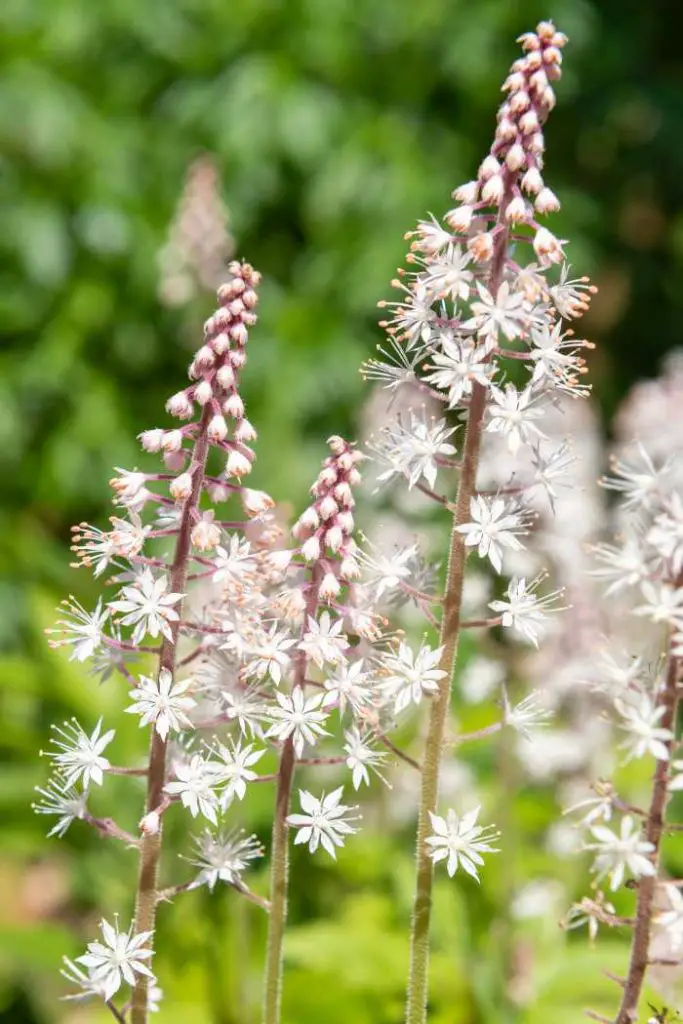
Nestled among the lush foliage of a shade garden, Foamflower‘s delicate white or pink blooms add a touch of elegance and charm to the landscape. To guarantee your Foamflowers thrive, provide them with moist, well-draining soil rich in organic matter.
These plants prefer partial to full shade, making them perfect for those shady spots in your garden. When it comes to care, remember to keep the soil consistently moist, especially during dry periods. Propagation of Foamflowers is best done through division in early spring or fall, allowing you to expand your Foamflower collection easily.
For a stunning garden display, consider pairing Foamflowers with other shade-loving plants like Hostas, Astilbes, and Bleeding Hearts. These companions not only complement Foamflowers aesthetically but also share similar growing conditions, making maintenance a breeze.
Their contrasting foliage textures and colors will create a visually appealing and dynamic garden bed. By incorporating these best companion plants, you can elevate the beauty of your shade garden and enjoy a harmonious plant community.
Solomon’s Seal
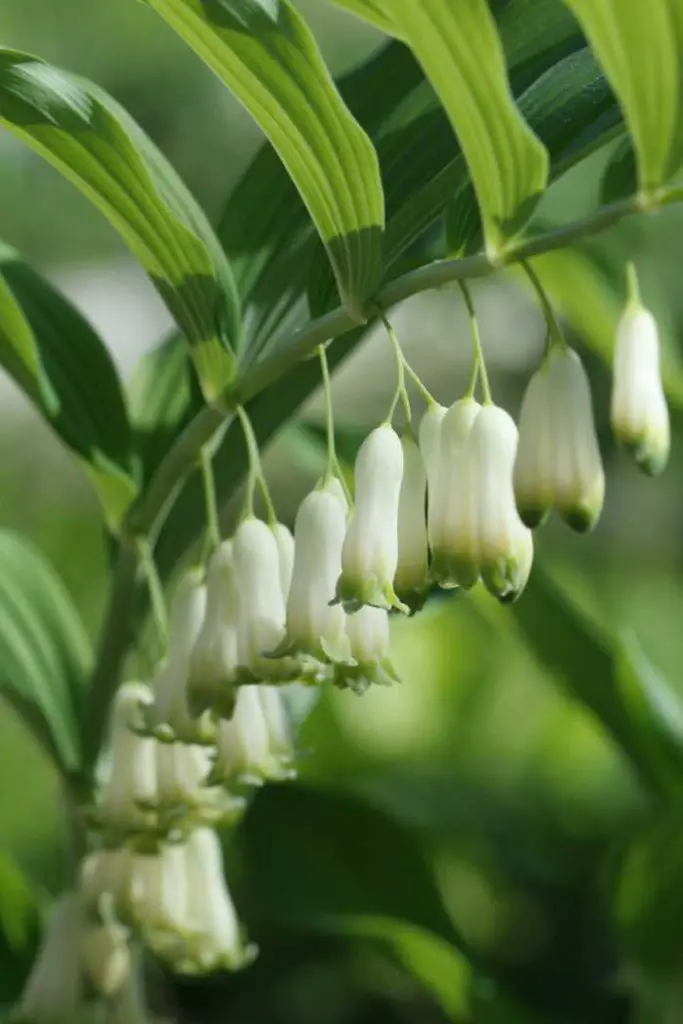
To cultivate a thriving shade garden, consider incorporating Solomon’s Seal, a graceful perennial known for its arching stems and dangling white flowers. Solomon’s Seal is a fantastic addition to any shade garden design, bringing a touch of elegance and uniqueness to the space.
Its long, arching stems create a beautiful cascading effect, making it a standout plant in shaded areas. The dangling white flowers that bloom in spring add a delicate charm to the garden, attracting pollinators and providing visual interest.
One of the reasons Solomon’s Seal is highly regarded in shade garden design is its ability to thrive in low-light conditions where other plants may struggle. This makes it a valuable addition for those looking to enhance their garden with unique shade plants.
Additionally, Solomon’s Seal is low-maintenance, requiring minimal care once established. Its attractive foliage also adds texture and depth to the garden, creating a serene and inviting atmosphere. Consider adding Solomon’s Seal to your shade garden for a touch of sophistication and beauty.
Japanese Forest Grass
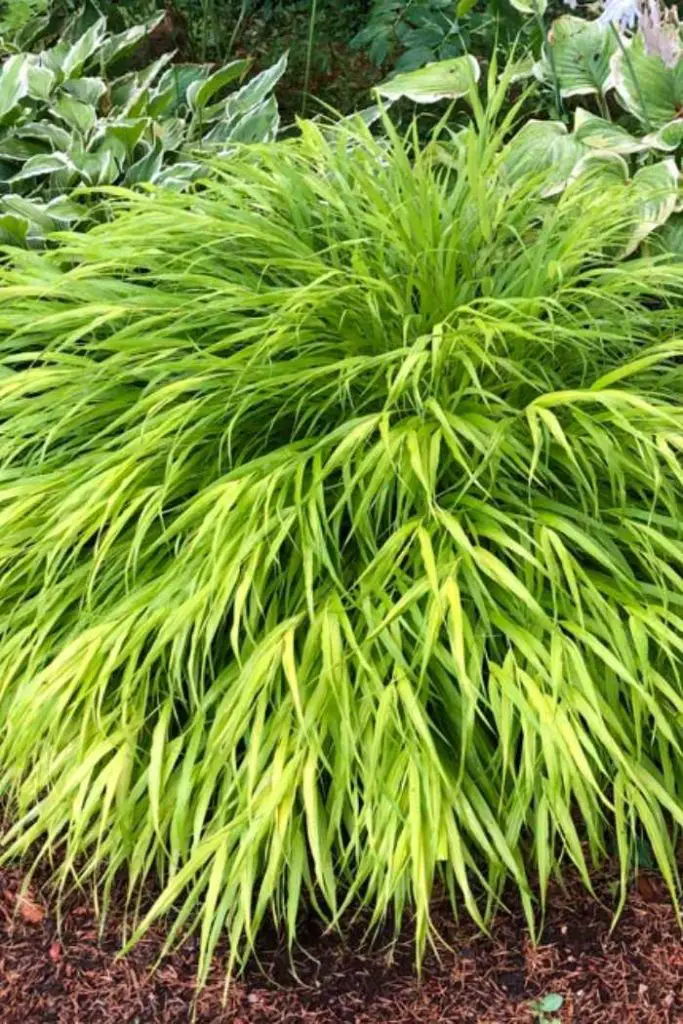
Consider incorporating Japanese Forest Grass into your shade garden design for a vibrant and unique touch that thrives in low-light conditions. Japanese Forest Grass, known for its graceful arching blades, adds a pop of color with its gold or variegated foliage.
This ornamental grass requires well-drained, moist soil rich in organic matter. When planting, make sure the soil is consistently damp but not waterlogged to meet its watering needs. To maintain its beauty, regular watering during dry spells is essential.
Companion planting Japanese Forest Grass with shade-loving plants like Hostas or Ferns creates a harmonious and visually appealing garden bed. When it comes to pruning techniques, this grass is relatively low-maintenance.
Simply trim back any dead or damaged blades in early spring to revitalize its appearance. This grass’s slow growth habit means you won’t have to worry about frequent pruning.
By following these soil requirements, watering needs, and companion planting tips, you can enjoy the beauty of Japanese Forest Grass in your shade garden year after year.
Bugleweed
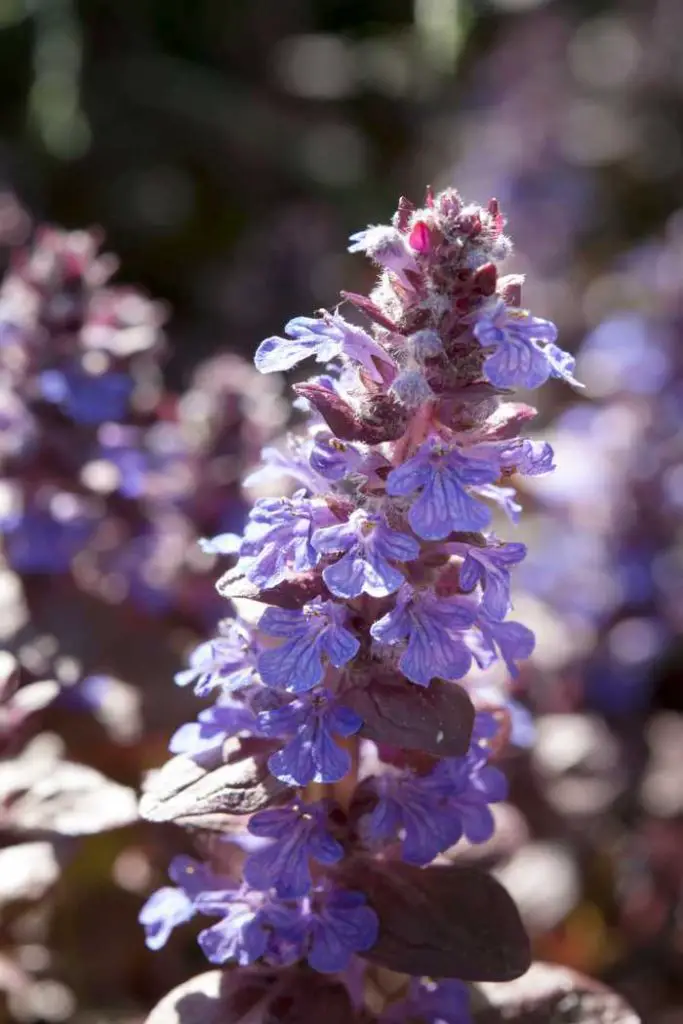
Bugleweed, also known as Ajuga, is a versatile perennial that thrives in shade gardens. With its attractive foliage and vibrant flowers, Bugleweed adds color and texture to any garden setting.
Plant Bugleweed in well-draining soil and provide ideal watering for best growth.
Bugleweed Characteristics
Exploring the shady corners of your garden, you may come across Bugleweed, known for its unique characteristics and versatility in landscaping.
Bugleweed, scientifically known as Ajuga reptans, is a low-growing perennial that spreads through runners, making it an excellent ground cover. When it comes to Bugleweed propagation techniques, division in spring or fall is the most common method. Simply dig up a mature plant, separate the roots into smaller sections, and replant them in the desired areas.
Bugleweed thrives in moist, well-draining soil, making it vital to guarantee proper drainage to prevent waterlogging. Additionally, Bugleweed soil preferences include slightly acidic to neutral pH levels. This plant can adapt to various light conditions, from full shade to partial sun, but it tends to perform best in partial shade.
Bugleweed’s foliage comes in different shades of green, burgundy, or variegated patterns, adding both texture and color to your shade garden.
Bugleweed Planting Tips
When planting Bugleweed in your shade garden, make sure the soil is moist and well-draining to promote healthy growth and prevent waterlogging. Bugleweed, also known as Ajuga, thrives in partial to full shade and requires consistent moisture to flourish.
Before planting, prepare the soil by incorporating organic matter to improve drainage and fertility. Dig a hole slightly larger than the plant’s root ball and gently loosen the roots before placing it in the ground.
For bugleweed maintenance, trim back any dead or damaged foliage in the spring to encourage new growth. Mulching around the base of the plant can help retain moisture and suppress weed growth.
Consider incorporating Bugleweed in your shade garden design to add texture and color variation. Its low-growing habit makes it ideal for ground cover or edging along paths.
Pair Bugleweed with other shade-loving plants like Hostas or Ferns to create a visually appealing and cohesive garden space. With proper care and attention, Bugleweed can be a beautiful addition to your shade garden landscape.
Toad Lily
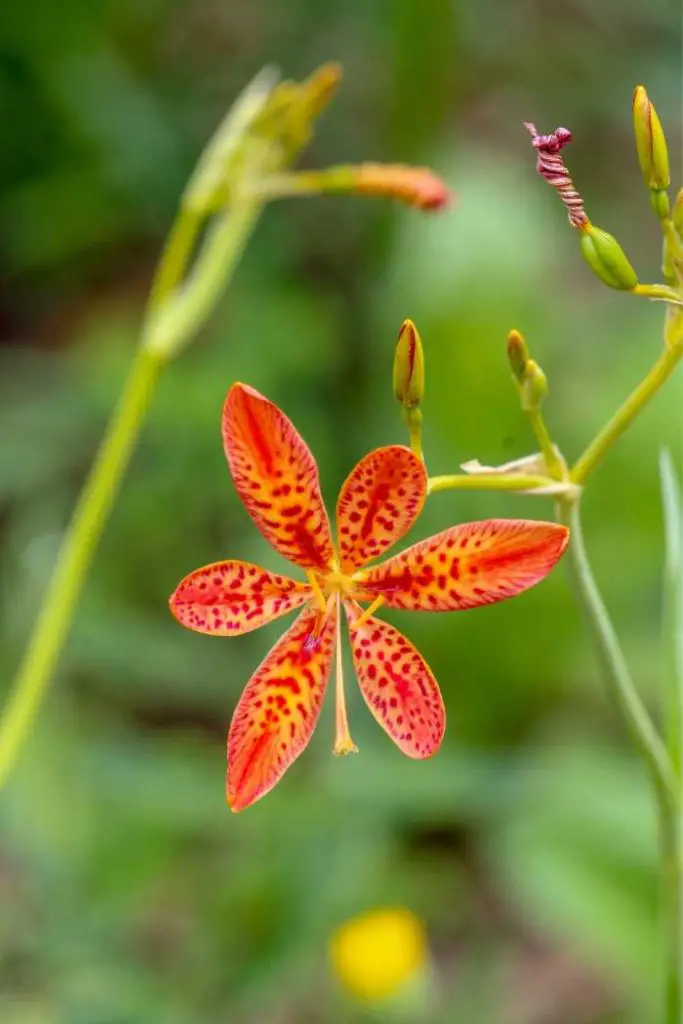
Toad Lily, known for its unique spotted flowers and preference for shady areas, is a stunning addition to any shade garden. When it comes to Toad Lily care, make sure to plant it in moist, well-draining soil enriched with organic matter.
These beauties thrive in partial to full shade, providing a pop of color where few other plants can bloom successfully. To propagate Toad Lilies, divide their rhizomes in early spring or fall for new plants.
To complement the beauty of Toad Lilies, consider planting them alongside ferns, hostas, astilbes, or Japanese forest grass. The delicate blooms of Toad Lilies pair beautifully with the lush foliage of these companion plants, creating a harmonious and visually appealing garden design.
Their late-season blooms bring a unique charm to your shaded areas, extending the interest and color palette of your garden well into the fall.
Incorporating Toad Lilies into your shade garden will surely elevate its aesthetic appeal and create a tranquil oasis for you to enjoy.
Hellebores
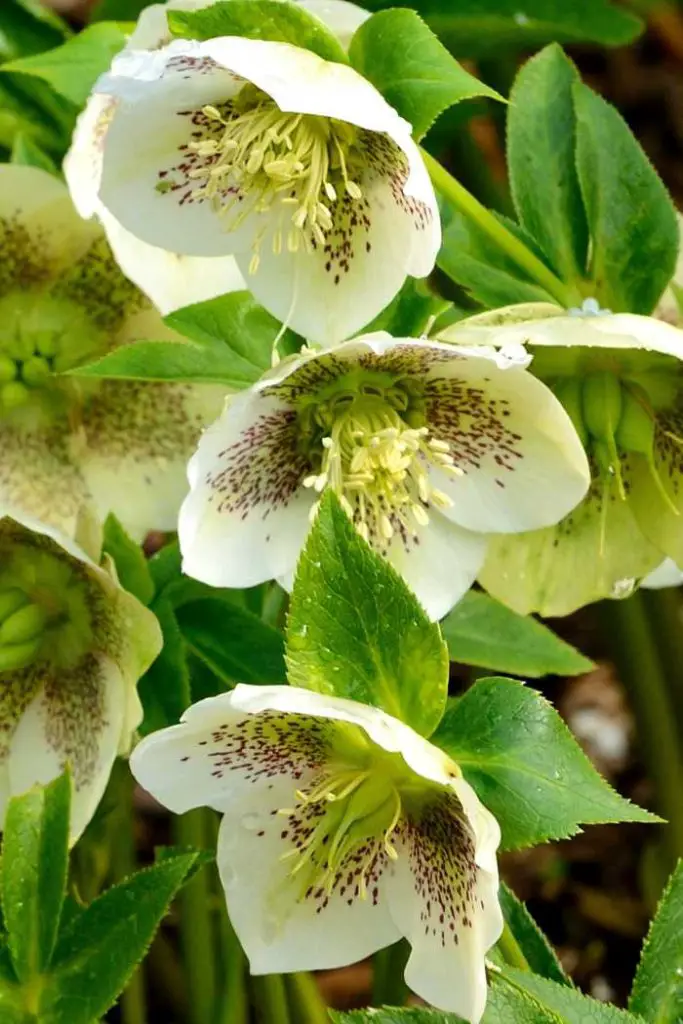
Hellebores, also known as Lenten roses, are exquisite perennial plants that thrive in shaded garden areas. These elegant flowers bloom in late winter to early spring, providing a burst of color when most other plants remain dormant.
Hellebores care is relatively low maintenance, requiring well-draining soil rich in organic matter and consistent moisture. When planting, make sure the crown of the plant is at soil level and mulch around the base to retain moisture.
Propagation of hellebores can be done through division or seeds. Dividing established clumps in early spring or late summer helps rejuvenate the plant and create new specimens. Collecting seeds from hellebores is another way to propagate these beauties, but keep in mind that they can take a few years to mature into blooming plants.
Incorporating hellebores into your shaded garden not only adds beauty but also a sense of tranquility. Their nodding flowers and evergreen foliage create a serene atmosphere, making you feel like you belong in a peaceful oasis.
Jacob’s Ladder

With their delicate clusters of bell-shaped flowers in shades of blue, purple, or white, Jacob’s Ladder plants add a touch of elegance to any shade garden. When it comes to shade garden design, Jacob’s Ladder is a perfect choice for adding vertical interest. These plants can reach up to 2 feet in height and are ideal for planting along borders or in the background of a garden bed to create depth and structure.
For successful Jacob’s ladder care, make sure they’re planted in well-draining, moist soil with partial to full shade. These plants thrive in cool, shaded areas and require regular watering to keep the soil consistently moist. Applying a layer of mulch around the base of the plants can help retain moisture and suppress weeds.
In terms of maintenance, Jacob’s Ladder is relatively low-maintenance and only requires occasional fertilization in the spring to support healthy growth. By incorporating Jacob’s Ladder into your shade garden design and providing proper care, you can enjoy their charming blooms and lush foliage throughout the growing season.
Frequently Asked Questions
Can These Shade Perennials Survive in Dry or Drought Conditions?
In dry or drought conditions, shade perennials can survive with proper watering techniques and suitable soil. Consider companion planting for added moisture retention and mulching strategies to help conserve water and maintain plant health.
Are There Any Shade Garden Pests That Commonly Affect These Plants?
To protect your shade garden from common pests like slugs and snails, use barriers like copper tape. Prevent diseases by ensuring good air circulation and avoiding overhead watering. Treat infections promptly with appropriate fungicides.
Do Any of These Perennials Attract Beneficial Pollinators or Wildlife?
When selecting shade garden perennials, prioritize pollinator-friendly varieties to attract beneficial insects and wildlife. These plants not only beautify your garden but also support biodiversity conservation efforts by providing food and habitat for various creatures.
How Do I Properly Divide and Propagate These Shade Garden Perennials?
When dividing and propagating shade garden perennials, you should carefully separate the plant into sections, ensuring each has roots attached. Plant in well-draining soil, keep consistently moist. Divisions can be done in spring or fall for best results.
Can These Plants Be Successfully Grown in Containers or Pots?
In container gardening, consider space limitations. Choose well-draining potting soil for shade perennials. Maintain drought tolerance by monitoring watering frequency. With care, these plants thrive in pots, bringing beauty to your limited space.
Conclusion
To sum up, when creating a beautiful shade garden, consider incorporating a variety of shade garden perennials such as:
- Hostas
- Ferns
- Astilbe
- Bleeding heart
- Lungwort
- Bugleweed
- Toad lily
- Hellebores
- Jacob’s ladder
These plants offer a range of textures, colors, and blooming times, ensuring year-round interest and beauty in your shaded outdoor space.
With proper care and maintenance, your shade garden will thrive and become a peaceful retreat for relaxation and enjoyment.





